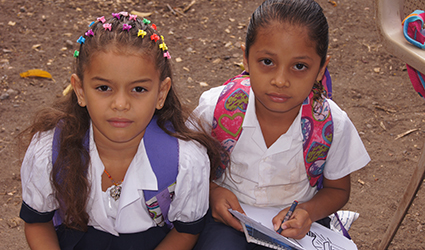 In March 2016, GRID Alternatives volunteers installed a 1kW off-grid battery-based solar electric (PV) system on an elementary school in San Juan de Paula, Boaco, Nicaragua. Volunteers had the opportunity to stay with families from the community for three days during the solar installation. Before and after the solar project, the group traveled around country to learn more about Nicaraguan geography, people and culture.
In March 2016, GRID Alternatives volunteers installed a 1kW off-grid battery-based solar electric (PV) system on an elementary school in San Juan de Paula, Boaco, Nicaragua. Volunteers had the opportunity to stay with families from the community for three days during the solar installation. Before and after the solar project, the group traveled around country to learn more about Nicaraguan geography, people and culture.
The community of San Juan de Paula belongs to the municipality of San Lorenzo, in the department of Boaco. It has 32 families with 160 community members who make their living through raising cattle and cultivating crops like corn, beans, wheat and dairy products.
Community members in San Juan de Paula struggle with health care, housing conditions and lack of opportunities for education for the children. Before the solar installation, there was no electricity in the community except for a few families that own a small solar home systems. Most families light their homes using candles and kerosene lamps. The closest health clinic for primary health care is a 30-minute walk to the community of La Trinidad – a community where GRID Alternatives installed a PV system at the school and health clinic in 2014. If someone requires special treatments, they have to be transferred to El Papayal hospital, which is a 3-hour walk away.
 The school in San Juan de Paula was built 12 years ago with support from the community. Community members provided labor and carried all the materials to raise the building. The school is a multi-grade school where 23 students are taught first through sixth grade during the week in two big classrooms. High school is offered every Saturday.
The school in San Juan de Paula was built 12 years ago with support from the community. Community members provided labor and carried all the materials to raise the building. The school is a multi-grade school where 23 students are taught first through sixth grade during the week in two big classrooms. High school is offered every Saturday.
The battery-based 1kW photovoltaic system that GRID volunteers installed provides lights and AC power for the school, which helps improve the quality of communication, education, and recreation for the town. Members of San Juan de Paula look forward to using the electricity at the school to charge cell phones and plug in small AC-powered appliances like fans, laptops, and radios. Classes can now be offered in the evenings at a convenient time for working adults and teachers now have an adequate place to stay in the community. Lighting at night helps teachers plan their lessons at night without having to commute into town to use electricity. The school can also serve as a meeting place for the whole community in times of emergencies.
To see photos from this project click here.

